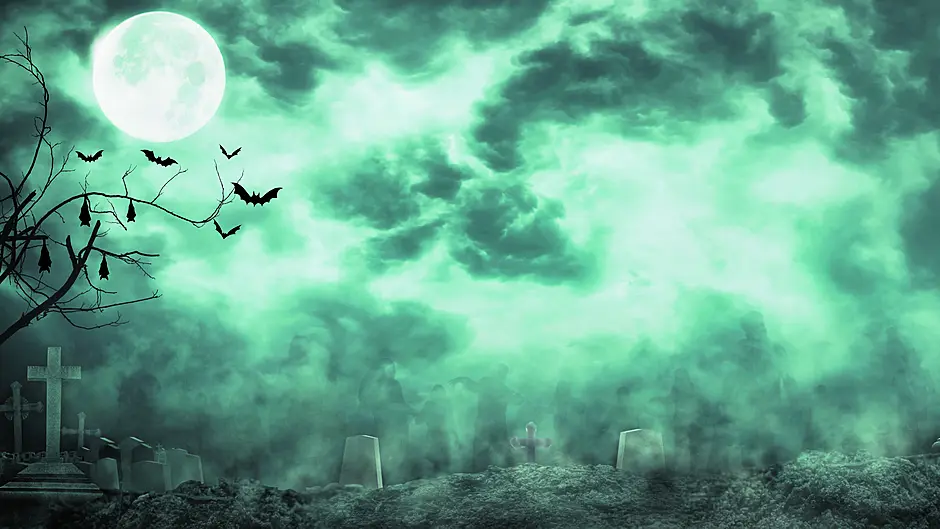This Halloween, PAULINE MURPHY delves into the Irish Folklore Commission’s collections of scary stories, contributed by West Cork children in the 1930s
FROM 1937 to 1939, the Irish Folklore Commission enlisted primary school pupils across the country to collect local lore and customs. It resulted in half a million written pages now digitised online at Duchas.ie.
Pupils from West Cork collected many local tales, including some about ghosts and strange happenings.
A Bantry pupil recalled a story about a ghostly woman who was often seen at Seskin Bridge late at night. ‘So frightened were the residents of meeting her that, if business kept them out late at night, they used to make a detour to their homes in order to avoid passing the bridge,’ she wrote.
One night a local man, sick of taking the long way home, decided to cross the bridge at Seskin. To his horror he came face-to-face with the mysterious woman. She asked him to convey a message to a priest, then placed her hand on the man’s arm and burned the print of her five fingers on it.
The startled man ran to a local priest’s house where he told him about the spirit at Seskin Bridge and showed him the mark on his arm.
The priest went to the bridge where he said prayers and sprinkled holy water. From then on, the mysterious ghost of Seskin Bridge was seen no more.
A pupil from Corran, Leap, told a tale about a ghost who haunted a local road.
 Late-night meetings with ghostly figures were a common occurrence in Ireland a century ago, judging from the stories of West Cork schoolchildren of the day! (Photo: Shutterstock)
Late-night meetings with ghostly figures were a common occurrence in Ireland a century ago, judging from the stories of West Cork schoolchildren of the day! (Photo: Shutterstock)
One night a man was walking home and took this particular lonely road at Keeling, Leap. ‘Suddenly, he heard a low unearthly moan and just then, he saw through a gap in the hedge a low stooped figure clad in white.’
The ghostly figure made its way to the road and followed the petrified man who quickened his walk homewards. When he finally made it home, the frightened man dashed inside and locked the door. When he looked through the window he witnessed the ghostly figure had ‘vanished in a flash of fire’.
A pupil in Castletownbere told a tale about a man from Clonaglaskin who was making his way home after a day’s work in the
Allihies mines. As he was taking a short cut across a mountain path, the man tripped and fell to his death over a cliff.
‘Since then, anyone crossing at that spot always cast a stone over the cliff so that the dead man’s spirit would not trouble them. And legend has it that anyone who does not cast a stone will die in the same way,’ wrote the pupil.
From Bantry, a pupil told a story about a haunting ‘near the parochial hall in Durrus in an old courtyard. This courtyard is supposed to be haunted as no one likes to pass through it after darkness has fallen.’
The story relates to the penal times. One day a local landlord was riding along the road on his horse when he came upon a local lad. The innocent boy did not stand to one side or bow his head as the landlord passed by, and for this he paid with his life.
A pupil from Cahirgarrif had a tale about a Bere Island man called Hanley. He was working in the Allihies mines and one night after he finished work he was crossing Knockoura Hill when he encountered a violent spirit.
‘Hanley was attacked by a ghost in the form of a red-haired woman. She attacked him on top of the hill, but he beat her off with a blackthorn stick. She followed him about three miles until he came to a river. It is said that ghosts cannot cross a river, so he jumped the river and she did not follow him any further. It is said that on account of the fright, he jumped fifteen feet when crossing the river, and two stones on each side of the river mark the distance to the present day.’
The following night Hanley encountered the red-haired ghost again in the same place but, unfortunately he did not survive the second attack. His lifeless body was found the next day with a fistful of red hair clutched in his fist.
A Bantry pupil had a strange tale about the woods surrounding Bantry House.
One night as some boys were venturing through the woods, one of them became separated from the group. The lost lad came across a gate and climbed it to get a better view of his surroundings when suddenly he saw a white figure.
‘The boy recognised the apparition as that of Lord Bantry, who had owned the grounds before he died. He got such a fright that he fell off the gate and broke his leg. The lad was later found by his friends unconscious. His leg never healed.’
 The woods around Bantry House were seen as a scary place for the children in 1930s West Cork! (Photo: Shutterstock)
The woods around Bantry House were seen as a scary place for the children in 1930s West Cork! (Photo: Shutterstock)
In Kilbrittain, a pupil told a tale about a strange encounter local fishermen had in 1860. As usual when the local fishermen would return from sea at night, they would anchor their boats on a sandbank opposite Courtmacsherry. One night, as they anchored their boats, they met a man wearing a white coat on horseback travelling in full gallop along the sandbank.
‘All the fishermen knew him as he was a local man, his name being Scott, and he was dead for about 20 years! Before his death he was a great horseman and used to wear a white coat.’
From Kilbrittain a pupil told a tale about a ghost who haunted the road between Timoleague and Clonakilty.
‘A red-haired woman was seen on the road for several nights about 10pm near Ashgrove. She beat all persons passing by.’
A priest was told about what occurred and he went to the scene and read some prayers and sent the woman ‘in a blaze of fire into the sea and she was never seen after.’
A pupil from Castlenalact, Brinny, told a tale about the white lady of Kilpatrick crossroads. ‘She is supposed to be seen crossing the road on a moonlit night. The tradition is that a horse bolted on that road and the girl driving it was killed there.’










